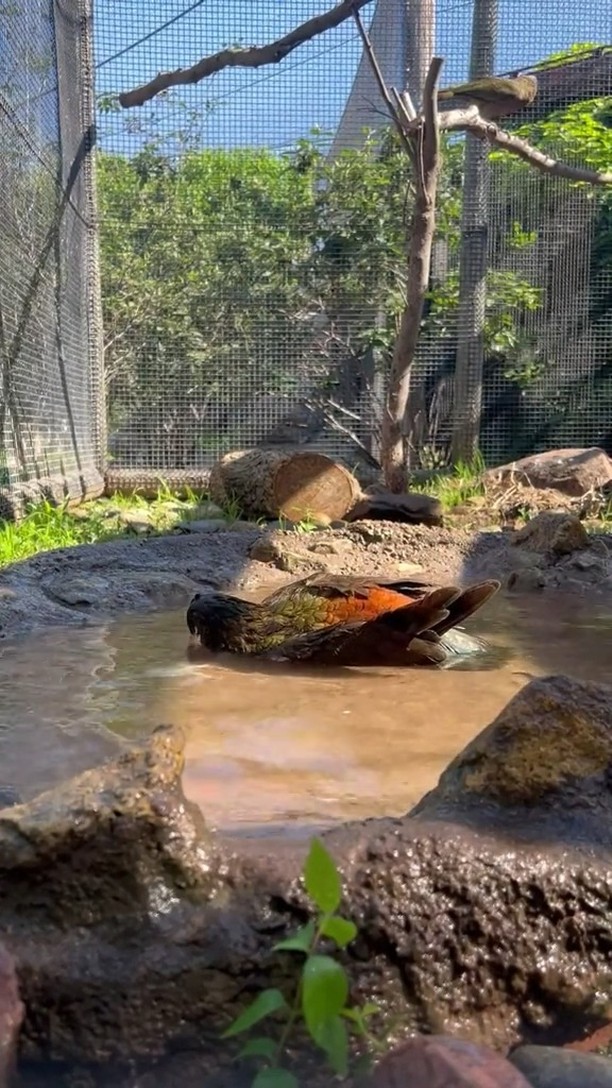- Understanding Kea Parrots and their behavior in captivity and natural habitats
- The role of zoos in wildlife conservation and education, featuring Sedgwick County Zoo
- Interactive and engaging zoo exhibits: Benefits for animals and visitors
- The importance of animal enrichment programs in zoos
- Modern challenges in zoo management and conserving endangered species
Kea parrots, native to the alpine regions of New Zealand, are an intelligent and curious species known for their playful nature. One such Kea, Arthur, recently gained attention from a heartwarming video shared by the Sedgwick County Zoo. In the video, he is seen thoroughly enjoying his return to the exhibit after a temporary hiatus. This moment offers a delightful glimpse into the behavior of these parrots, who are often seen as clowns of the bird world due to their curious and friendly demeanor.
Keas, scientifically known as Nestor notabilis, are the only alpine parrot species in the world and are unique due to their adaptability to cold environments. In the wild, they have been observed engaging in playful behaviors, such as sliding down snowy roofs, nibbling on tourists’ shoes, and even using tools—signs of their remarkable intelligence. However, Keas in captivity, like Arthur, depend on zookeepers and the environment provided by the zoo to maintain these natural behaviors and ensure their overall well-being.
The Sedgwick County Zoo, like many modern zoological institutions, plays a significant role in wildlife conservation and environmental education. Zoos provide shelter and care for various animals, many endangered or threatened in the wild. By doing so, they contribute to preserving biodiversity and offer humans the opportunity to experience wildlife up close, fostering connections and promoting conservation efforts. Exhibits are carefully designed to mimic natural habitats and provide necessary resources, such as space, enrichment activities, and proper nutrition, ensuring that animals like Arthur can thrive.
Interactive and engaging exhibits at zoos prove beneficial not only for visitor education but also for the animals themselves. These exhibits allow animals to exhibit natural behaviors, giving visitors a more authentic view of the species. Arthur’s animated behavior indicates a well-adjusted and stimulated Kea, signaling a successfully designed environment. Exhibit designs consider the sensory and physical needs of the animals, often including elements such as climbable structures, water features, and foraging opportunities to simulate the challenges and pleasures of life in the wild.
Animal enrichment programs are essential in maintaining zoo animals’ physical and psychological health. Enrichment can take various forms, such as novel food presentations, sensory stimulants, puzzle toys, and caretaker interaction. For intelligent species like the Kea, these enrichment activities are critical to prevent boredom and encourage behaviors they normally display in their natural habitat. Watching Arthur navigate his exhibit with glee illustrates the value of these enrichment initiatives— he appears to be exploring and playing just as he might in the mountainous forests of New Zealand.
Zoo management faces modern challenges that involve balancing animal welfare, public engagement, and conservation priorities. Endangered species such as the Kea are losing their natural habitats due to deforestation, climate change, and human encroachment. Zoos act as arks for these species, providing a sanctuary where they can live safely and breed under managed care programs. Zoo professionals collaborate with conservationists to support reintroduction programs and protect wild populations. The fruition of these efforts often relies on zoo-generated funding, awareness campaigns, and educational outreach.
The Sedgwick County Zoo—and other institutions with similar commitments—has a critical role in bringing people and wildlife together, facilitating a deeper understanding and appreciation for nature’s marvels embodied by animals like Arthur the Kea. His ability to captivate audiences exemplifies the impact of zoos in inspiring conservation action. Arthur’s evident joy and the public’s positive reaction to his ‘dance’ underscore the significant impact of these opportunities for engagement.
In summary, the video of Arthur the Kea represents more than a playful moment—it signals successful zoo practices in animal care, exhibit design, enrichment, and public education. This single piece of media serves as a testament to the efforts zoos put forth in conservation and brings to light the importance of their work for both wildlife and human societies. As viewers share in Arthur’s happiness, they unknowingly support a larger mission aimed at sustaining the delicate balance of our planet’s rich and varied species. The collective effort of zoos worldwide emerges as a force for good, championing the cause of animals one exhibit at a time.
*****
Source Description
Enjoy this moment of Arthur the kea getting absolutely lost in the sauce. 🥴😅 He was having a blast adjusting to being back on exhibit at Sedgwick County Zoo.
🎥Video Credit: Keeper Julianne


